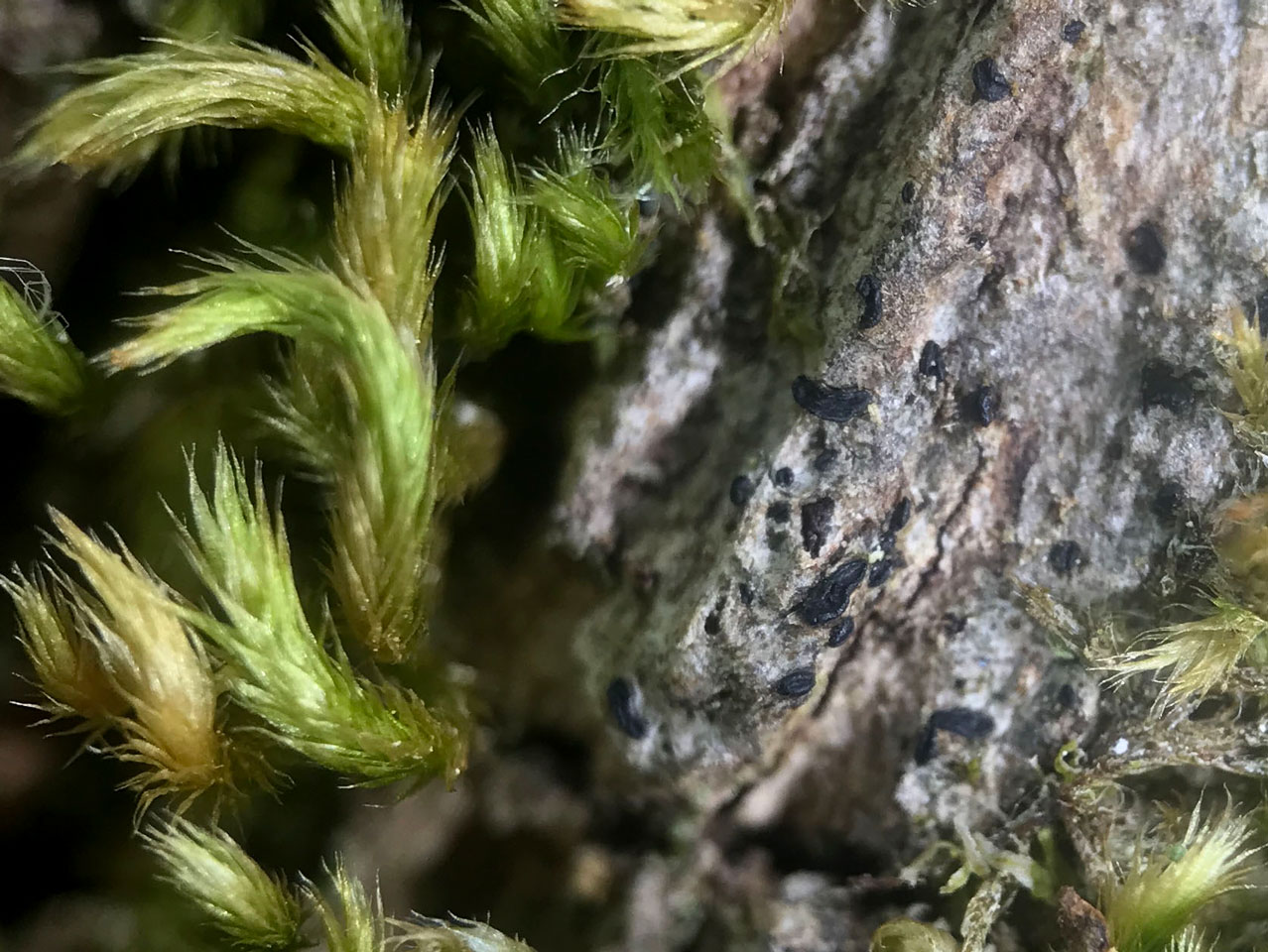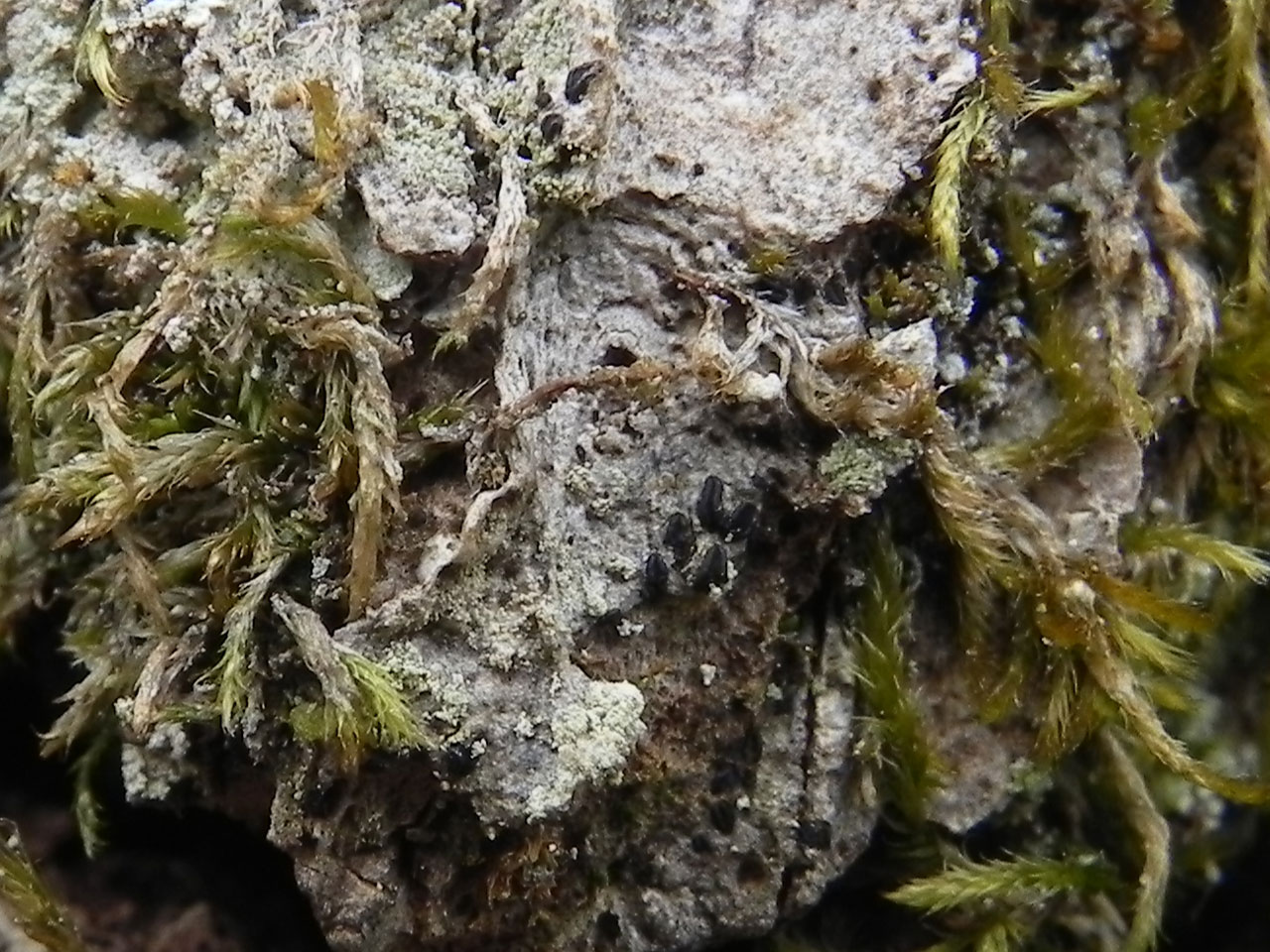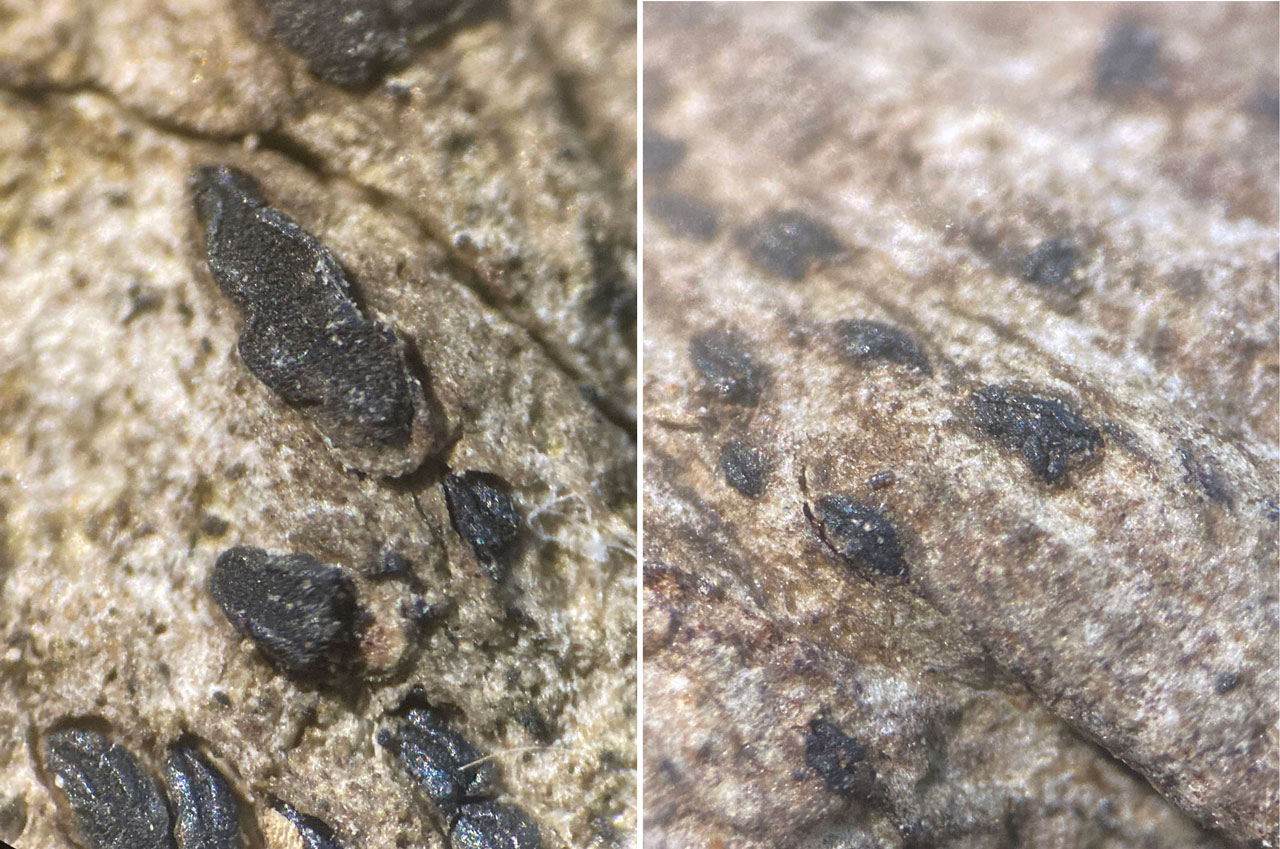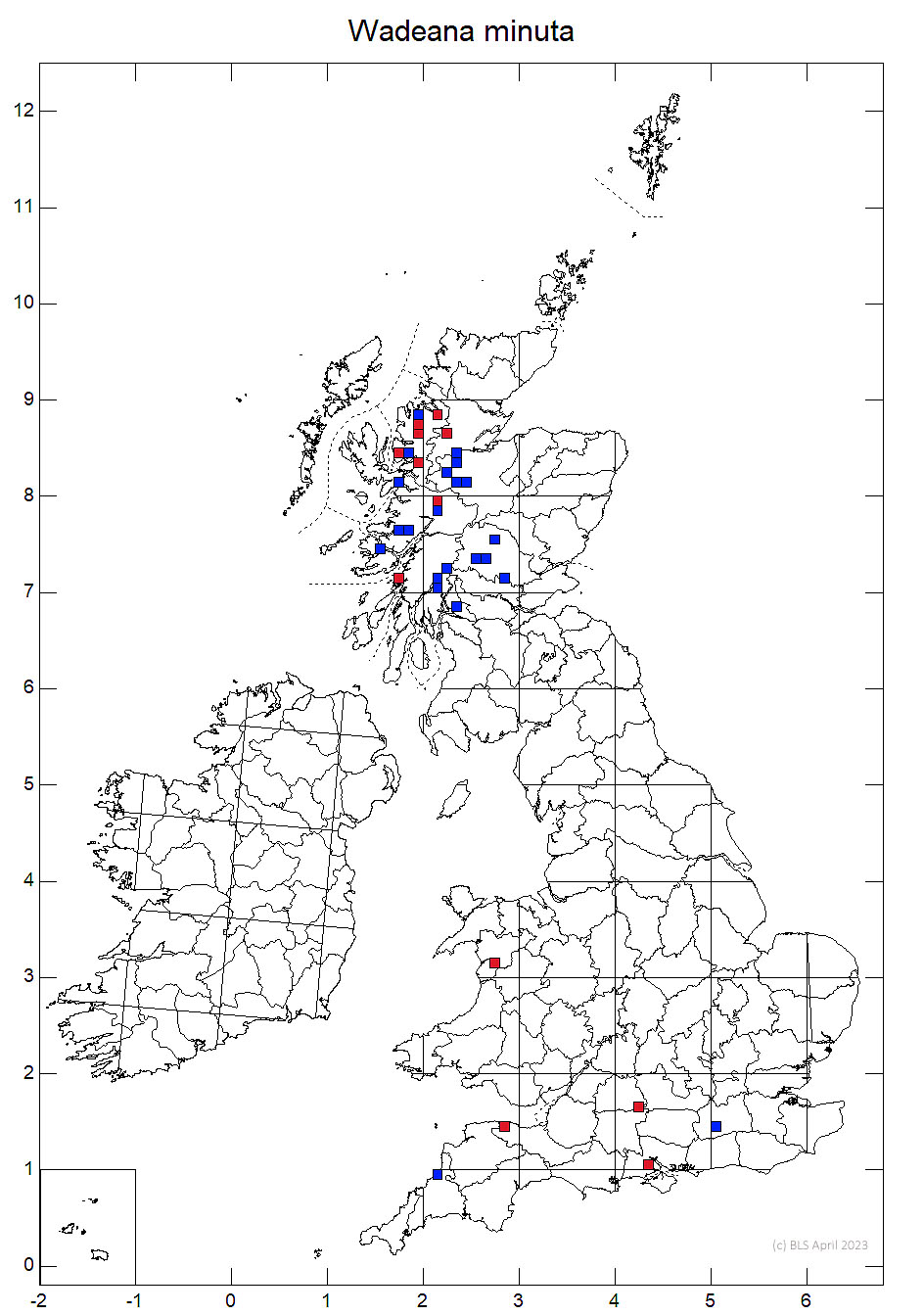Wadeana minuta
The small lirellate apothecia of Wadeana minuta are easily over looked as those of Alyxoria varia (Opegrapha varia) or a non lichenised fungus such as Hysterium angustatum. The open disk separates the W. minuta from Hysterium species and the shiny margin from the dull margins of Alyxoria species. The apothecia are much smaller and have rounded ends when compared to the similar Wadeana dendrographa. Wadeana minuta is found on intermittently flushed base rich bark that is not wet enough for bulky late succession mosses such as Homalothecium sericeum. It is typically found on well lit veteran trees including Oak, Ash and Elm in glades and wood edges in old growth pasture woodlands and in old parklands or Scottish policies. It appears to always be rare and found only on a few trees at any one site. Mainly found in the Highlands but with a few sites in Wales and England.
Thallus corticolous, endophloeodal, inapparent, sometimes discernible as a faint pale stain. Apothecia lirellate, minute, 0.25-0.8 × 0.2-0.3 mm, shortly elongate or oval, sometimes clustered, not or 1-branched; margin (true exciple) smooth, ± glossy, persistent, 30-40(-60) μm wide; hymenium 50-60 μm tall. Asci (35-)40-45 × 12-18 μm, c. 100-spored. Ascospores 2-3 μm diam., ± globose. (From Sanderson & Hawksworth, (2009)).
Externally distinguished from similar-looking Alyxoria species (e.g., A. culmigena & A. varia) by the ± glossy margin to the apothecia. Also Alyxoria apothecia are general randomly orientated, while Wadeana species are typically orientated parallel and vertically. Wadeana minuta can be field separated from W. dendrographa by the the smaller apothecia of W. minuta, which are shortly elongate or oval with blunt end as opposed to W. dendrographa which has larger apothecia (0.5-2.5 × 0.3-0.5 mm) which are elongate with more attenuated ends.
Wadeana minuta is found either in or near old growth pasture woods or old parks/policies with frequent veteran trees. It is found in some quite open situations such as roadside trees on woodland edges, parkland and the grounds of big houses in Scotland. Within more closed woodlands is it usually found in the more open parts of the woodland.
In its heartland, within the Scottish Highlands, it is recorded from a variety of tree species, with 22 records from Ash, 16 on Oak, six from Elm and once on Hawthorn. The majority of the Ash records are from the hyper-oceanic rainforests of the Western Highlands, with Oak more significant in the eastern Highlands. To the south, in Wales and England the lichen only occurs on Oak (Sanderson, 2021).
Wadeana minuta is clearly dependent on base rich flushed bark but is too small to compete the strong growth of robust mosses such as Homalothecium sericeum on the wettest bark. It is confined to the fringes of the flushed areas, where the moss growth is weakened, so there is some open bark. The habitat requirements were summarised by Sanderson (2021):
- Veteran trees with base rich bark in sheltered but well lit conditions mainly in pasture woodland and parkland. Maintaining well lit and aerated conditions in open stands with veteran trees is likely to be critical.
- As a mid-succession species of a specialist niche on base-rich bark, easily lost to increased moss growth and occurring at low densities, long term survival is mostly likely in large sites where suitable new habitat is regularly available, i.e. extensive old growth habitats with a good continuity of habitat.
- A mix of trees with the potential to support the species, with different tree species being the most important habitat in deferent regions.
- Low atmospheric pollution, particularly low levels of acidifying pollution, but also low levels of ammonia.
Coppins & James (1978) list associated species in Scotland as Biatora beckhausii, Candelariella xanthostigma, Collema subflaccidum, Gyalecta derivata, Gyalecta flotowii, Gyalecta truncigena, Lepraria incana s. lat. Leptogium burgessii, Normandina pulchella, Parmeliella triptophylla, Physconia distorta, Piccolia ochrophora, Rostania occultata (Collema occultatum) NT (NS) & Scytinium teretiusculum (Leptogium teretiusculum).
Assocaited species have been listed from a few trees recently in England & Wales:
- Cwm y Esgob, Elan, Breconshire (VC42): associated species, bryophytes: Homalothecium sericeum & Metzgeria furcata, lichens: Lepra albescens var. corallina & Lepraria finkii.
- Frame & Stubbs Woods, New Forest, Hampshire (VC11): associated species, bryophytes: Homalothecium sericeum & Isothecium myosuroides and lichens: Agonimia octospora, Coenogonium confusum, Cresponea premnea, Enterographa crassa, Lepraria finkii, Pachyphiale carneola, Skyttea nitschkei (on Thelotrema lepadinum) & Thelotrema lepadinum. These suggest high pH, intermittently flushed bark, which dries out rapidly.
- Savernake Forest, Wiltshire (VC7): the main associated species was the base demanding moss Homalothecium sericeum, with the lichen Bacidia rubella.

The species has a very patchy distribution in Britain, being widespread in the Scottish Highlands but very rarely recorded to the south. There are two records from Wales and a scatter of records in southern England from Exmoor to Surrey of isolated single sites, but some with multiple finds, including recent records. The record from Cornwall appears to be a transcription error. (Sanderson, 2021)
The Highland records occur in three regional clusters:
- The South West Highlands: records from Mid Perthshire (VC88) and Dunbartonshire (VC99) outside of the hyperoceanic rainforests of western Scotland, raging from oceanic to sub-oceanic in parks on the fringe of the Highlands and pasture woodlands within the Perthshire Highlands. Recorded five times on Oak, five times on Ash and once on Elm. No recent records in the BLS database (possibly reflecting lack of recent detailed resurvey in this area), but it has been recorded post 2000 in the Dumbarton site (Ross Park), also on Oak, but this is not yet entered into the database.
- Western Highland Rainforests: records from western Inverness (VC97), mainland Argyll (VC98), Skye (VC104) and West Ross (VC105) within the hyperoceanic rainforests of western Scotland. Mainly recorded within pasture woodlands, but with some records from policy woodland near big houses. Recorded six times on Oak, fifteen times on Ash, three times on Elm and once on Hawthorn. Half the 10km squares have recent records.
- The Eastern Straths: records from East Inverness (VC96) and East Ross (VC106) from sub-oceanic woodlands from Glen Moriston to Srath Ban in the north. In open pasture woodland and roadside veteran trees near woods, with one post 2000 record and five pre 2000 records: possibly reflecting lack of recent detailed resurvey in this area. Recorded four times on Oak, two times on Ash and twice on Elm.
There are only two records from Wales from 2009 and 2022:
- Dol-y-cae, Fawnog, below Cadair Idris, Merionethshire (VC48): recorded from an old Oak with Pachyphiale carneola in open pasture woodland in the valley bottom at the base a wooded slope. Recorded by Steve Chambers in 2009.
- Cwm y Esgob, Elan, Breconshire (VC42): rare on an ancient Oak in open area within a pasture woodland. Recorded by Neil Sanderson 2022.
There are records of Wadeana minuta from four sites in England:
- Albury Park, Surrey (VC17): an ancient deer park with the richest epiphytic lichen assemblage known in Surrey. Wadeana minuta was recorded by Francis Rose in 1971 and refound by Frank Dobson 1996, but not seen in 2016 or 2021. It occurred on an ancient Oak in a sheltered valley in old parkland with Thelopsis rubella. In 2021, two suitable Oaks were found at the location but W. minuta was not located (Sanderson, 2021).
- Frame & Stubbs Woods, New Forest, Hampshire (VC11): an exceptionally rich woodland complex within the New Forest, with large areas of old growth pasture woodland dominated by old Oaks. Wadeana minuta was recorded by Dr Francis Rose 1980 – 1984 in Stubs Wood to the east. The lichen was later refound over 1km west of this in Frame Wood (SU3502) in 1996 during a BLS meeting (Neil Sanderson & Bryan Edwards). A third tree was found about 200m east of this (SU3503) by Neil Sanderson in 2017. Sanderson (2021) found that the Stubs Wood sit had become more shaded due the late 20th century regeneration. The veteran Oaks were still very lichen rich but appeared in too humid a habitat for W. minuta now. The second Frame Wood tree was refound, a post mature Sessile Oak hybrid by a Bracken glade formed by tree fall on the edge of in grove of old Oak. Wadeana minuta was occasional, scattered thinly in small patches in the junction between mossy and dry bark. The 1996 Oak was not refound and there had been some windblow in this area, so the tree may have fallen.
- Savernake Forest, Wiltshire (VC7): a large relic pasture woodland in North Wiltshire, although damaged by planation forestry since the 1940s, it still supports a rich lichen assemblage. Restoration of the pasture woodland by the managers, Forestry England, is on going. Wadeana minuta was found in 2013 on an Oak in an area opened up pasture woodland restoration. On flushed base rich bark, W. minuta was growing where the moss was thinning out towards drier bark.
- Horner Wood, Somerset (VC5): an extensive and exceptionally rich oceanic pasture woodland. The woodland is still grazed but past declines in grazing pressure had lead to the spread of Hawthorn and Holly and increasing shade, but this has since been treated by the owners, the National Trust. W. minuta has two records from the woodland in 1998 and 2016. The first record was made by Brian Coppins and Sandy Coppins and the latter by Neil Sanderson, the records were just over 200m apart. Both were recorded from old Oaks.
A very localised lichen of base rich bark on well lit trees in old growth woodlands, especially by glades and wood edges and in parkland/policy grounds, with naturally low population densities. Localised data gives the minimum number of trees from which it has been recorded as about 53 (44 Scotland , 2 Wales & 7 England), not all of which will now be extant. A species dossier has been prepared (Sanderson, 2021) and summarised the threats to this species:
Unsuitable Long Term Management of Wider Habitat: given the apparent low density of occupation, thriving Wadeana minuta populations are likely to need large areas of well managed old growth woodland or parkland. This habitat needs to include numerous suitable well lit old or slow growing trees, in woods with frequent glades, in sheltered and humid locations. Wadeana minuta appears to be particularly light demanding and likely to be vulnerable to increasing shade. Declining grazing pressure, or even direct removal of grazing, is a significant threat to traditionally grazed lichen rich pasture woodland sites. This increases the levels of shade and humidity, the latter in particular increasing moss cover on base rich bark, which can rapidly exclude the species.
Loss of Locally Utilised Trees to Novel Tree Diseases: the impact of Dutch Elm Disease potentially had a significant impact on W. minuta in the Highlands, but there is no resurvey data to measure this. Ash Dieback is likely to have a serious impact in the Highlands, especially in the west Highlands, but is not likely have any impact in England and Wales
Impact of Air Pollution: acidifying pollution from sulphur dioxide is likely to have destroyed the habitat for W. minuta on Oak bark in parts of England. Albury Park, Surrey, where it appears to have been lost, suitable Oaks supporting base rich bark were rare and would have been reduced in number by sulphur dioxide pollution in the 20th century. Ammonia, mainly sourced from agriculture, is a more short distant pollutant but is potentially a threat where intensive agriculture, such as pig or chicken units, are spreading into previously relatively clean areas. This has been an on going issue within mid Wales (Bosanquet, 2019). As a light demanding lichen that can grow on wood edge trees and in parkland, W. minuta is likely to be more vulnerable than many other old growth dependant lichens to intensification of adjacent land use.
Lack of up to Date Data: the lack of up to date data for W. minuta in the east of Scotland raises issues of inadequate surveillance of rare lichen species. Without monitoring data it is very difficult to respond adequately to new threats.
Britain: Near Threatened
Scotland: Priority Taxon for Biodiversity in Scotland
Wales: Data Deficient
England: Section 41 species
Bosanquet S. D. S (2019) Lichen surveys to investigate ammonia impacts. NRW Evidence Report No: 298. Natural Resources Wales, Bangor.
Coppins, B. J. & James, P. W. (1978) New or Interesting British Lichens II. Lichenologist 10: 179-20.
Sanderson, N. A. (2021) Wadeana dendrographa Dossier. A report by Botanical Survey and Assessment for Natural England.
Sanderson, N. A. & Hawksworth D. L. (2009) Wadeana Coppins & P. James (1978) . In: The Lichens of Great Britain and Ireland (eds: C. W. Smith, A. Aptroot, B. J. Coppins, A. Fletcher, O. L. Gilbert, P. W. James & P. A. Wolseley) 962-963.
Text by Neil A Sanderson based on Sanderson & Hawksworth (2009) & Sanderson (2021)



